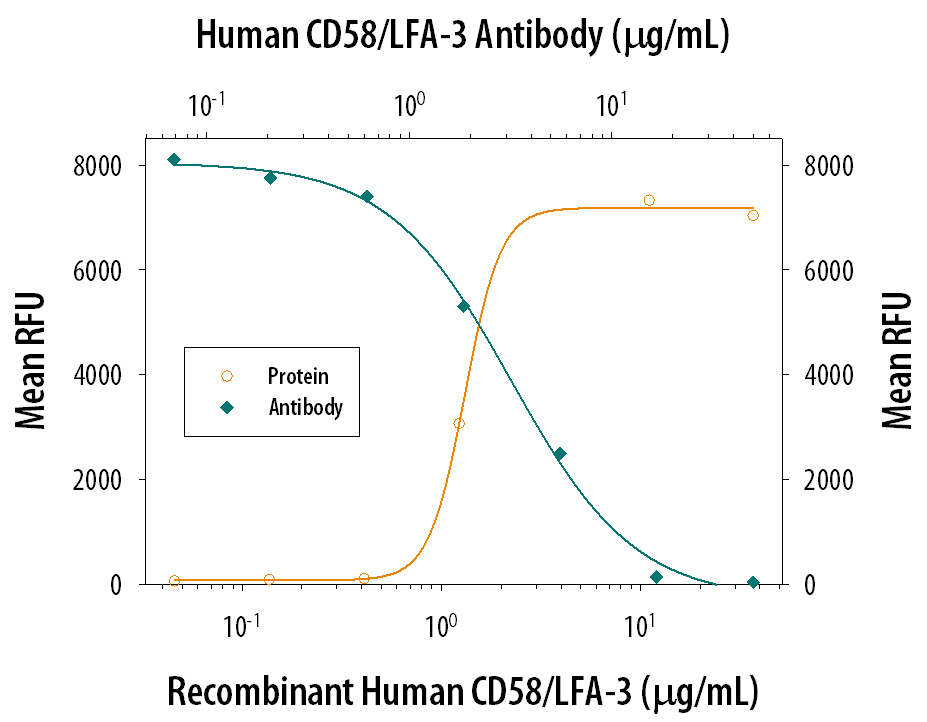Human CD58/LFA-3 Antibody
R&D Systems, part of Bio-Techne | Catalog # AF1689


Key Product Details
Species Reactivity
Validated:
Cited:
Applications
Validated:
Cited:
Label
Antibody Source
Product Specifications
Immunogen
Phe29-Arg215
Accession # P19256
Specificity
Clonality
Host
Isotype
Endotoxin Level
Scientific Data Images for Human CD58/LFA-3 Antibody
CD58/LFA-3 in Human Tonsil.
CD58/LFA-3 was detected in immersion fixed paraffin-embedded sections of human tonsil using 15 µg/mL Goat Anti-Human CD58/LFA-3 Antigen Affinity-purified Polyclonal Antibody (Catalog # AF1689) overnight at 4 °C. Tissue was stained with the Anti-Goat HRP-DAB Cell & Tissue Staining Kit (brown; Catalog # CTS008) and counterstained with hematoxylin (blue). Specific labeling was localized to the plasma membrane of lymphocytes in lymphatic nodules. View our protocol for Chromogenic IHC Staining of Paraffin-embedded Tissue Sections.Cell Proliferation Induced by CD58/LFA‑3 and Neutral-ization by Human CD58/LFA‑3 Antibody.
Recombinant Human CD58/LFA-3 (Catalog # 1689-CD) stimulates proliferation in the human CD3+T cells in a dose-dependent manner (orange line). Proliferation elicited by Recombinant Human CD58/LFA-3 (0.2 µg/well) is neutralized (green line) by increasing concentrations of Goat Anti-Human CD58/LFA-3 Antigen Affinity-purified Polyclonal Antibody (Catalog # AF1689). The ND50 is typically 3-12 µg/mL in the presence of Mouse Anti-Human CD3 Monoclonal Antibody OKT3 (2 ng/well).Applications for Human CD58/LFA-3 Antibody
Immunohistochemistry
Sample: Immersion fixed paraffin-embedded sections of human tonsil
Western Blot
Sample: Recombinant Human CD58/LFA-3 (Catalog # 1689-CD)
Neutralization
Formulation, Preparation, and Storage
Purification
Reconstitution
Formulation
Shipping
Stability & Storage
- 12 months from date of receipt, -20 to -70 °C as supplied.
- 1 month, 2 to 8 °C under sterile conditions after reconstitution.
- 6 months, -20 to -70 °C under sterile conditions after reconstitution.
Background: CD58/LFA-3
T cells require a signal induced by the engagement of the T cell receptor and a “co-stimulatory” signal(s) through distinct T cell surface molecules for optimal T cell expansion and activation. Many cell-bound receptor-ligand pairs have now been shown to be involved in T cell co-stimulation including CD58/CD2 in humans and CD48/CD2 in mice and rats. CD58, also known as lymphocyte function-associated antigen (LFA-3), is a 210 amino acid protein that belongs to the CD2 family of the immunoglobulin superfamily (1). CD58 is widely expressed on hematopoietic and non-hematopoietic human tissue and has been found on leukocytes, erythrocytes, endothelial cells, epithelial cells and fibroblasts of human origin (2). No mouse or rat homolog of CD58 has as of yet been identified. CD58 has only one known ligand, CD2. CD2 is expressed on T cells, NK cells and dendritic cells (2-4). CD2 ligation by CD58 has been shown to mediate T cell adhesion, T cell activation, T cell cytokine production, and T cell and NK cells cytotoxic activity (1, 3, 5, 6). In dendritic cells, CD2 engagement increases MHC Class II, CD40, CD80, CD86, CD58, and CCR7 and induces IL-1 beta and IL-12 cytokine secretion (4).
References
- Davis, S.J. and P.A. van der Merwe (1996) Immunol. Today 17:177.
- Smith, M.E. and J.A. Thomas (1990) J. Clin. Pathol. 43:893.
- Bolhuis, R.L. Roozemond, R.C. and R.J. van de Griend (1986) J. Immunol. 136:3939.
- Crawford, K. et al. (2003) Blood 102:1745.
- Kanner, S.B. et al. (1992) J. Immunol. 148:2023.
- Bullens, M.A. et al. (2001) International Immunol. 12:181.
Alternate Names
Gene Symbol
UniProt
Additional CD58/LFA-3 Products
Product Documents for Human CD58/LFA-3 Antibody
Product Specific Notices for Human CD58/LFA-3 Antibody
For research use only
